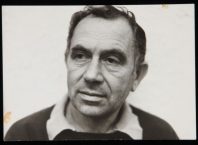
There’s a photograph on the wall behind the butcher, from a series called Organic Gardens by the photographer Seffy Bleier. it depicts the entrails of an animal, presented in curiously de-contextualised manner: the sterility, the singular focus, the cleanness of the photograph, very much at odds with the content.
And then, there’s the fact that I’m in a butcher’s shop.
A customer places an order. The butcher presents a side of beef and chops it into small pieces with a cleaver. The work is grisly and messy, but his actions are swift, economical. In minutes, the mess of blood and bone is neatly packaged, the customer sent on his way.
It might be that the photograph is in the right place after all.
Art – the arts in general – is often a matter of context. A work rarely stands by itself, but is rather a ruminative aspect of a deeper setting – history, religion, the marketplace of ideas, gender relations, whatever. The point is that when we talk about Art as the mirror with which we make sense of our lives, what we really mean is that is gives us – ought to give us, at least – pause for thought about the overlooked minutiae of everyday life. But we don’t always get to this point, do we?
Re-Orientation, the theme of the second Mediterranean Biennale currently taking place in Saknin (the first took place in Haifa in 2010) is a conscious play on words. The Orient – which is to say the detached conceptualisation of the Middle East drawn from a bygone age – needs to be dragged forcefully into the present. But there is also what we are presented with now: the Mediterranean is in a state of flux, from Greece to Tunisia and in most places in between. Art can’t solve these problems, but might just be able to give us a better understanding of what these may be.

The judgement call by co-curators Belu-Simion Fainaru and Avital Bar-Shay to site the second Mediterranean Biennale in the Galilee town of Sakhnin is both rational and radical. Rational because it is a conscious effort to draw the conversation out from the sometimes self-referential, not-entirely-representative art scene that congregates about the centre of Israel. But it is radical for exactly the same reason. Sakhnin, nestled in the hills of the Galilee, is geographically removed from the conversation about art. As an Arab-Israeli enclave surrounded by – and often removed from – its Jewish-Israeli surroundings, it is also excluded from the conversation dominated by the mainstream. The curators talk about striving to find a new direction for discourse on the subject of the East: They aspire to create “a culture drawing on its inspiration from the surroundings.” Or, to put it differently, putting the East back into the Middle East.
Sakhnin is an unknown to many Israelis, more the consequence of its demographic constitution as its relative remoteness. (When I told a friend that I was visiting the town as part of a press tour, she asked if we were going in numbers for our personal safety.) The truth is that it isn’t very much different from any number of towns and small cities on the periphery of the Israeli consciousness. Dusty streets, an identikit shopping mall, the lingering sense of disconnect and potential unrealised. Economic concerns are certainly much the same. As Mazen G’Nayem, Mayor of Sakhnin observes, it is bound to rankle if the citizens feel that “the taxes they pay are for the benefit of Misgav (a Jewish town, somewhat more affluent, a bit further up the road).
But what more can we learn about the bigger picture from a traipse around Sakhnin? Organisationally, it would be hard to pick holes in the overriding intent. Three separate routes, anchored by the city centre, the Doha International Stadium (a little more about this later) and the old city allow for a necessarily condensed yet reasonably representative snapshot of everyday life.
The real inspiration lies in the stations, as chosen by Faineru and Bar-Shay. There’s the aforementioned butcher’s shop, for instance. The municipality offices double as a walk through gallery, creating the interesting, subliminal perception of open democracy. Al-Zahraa, a organisation promoting feminist emancipation, provided a convivial and educative counterpart to the dominant cliche of the Arab sector and repressed women. A beguiling video, Hand Work, by the video artists Anne Anders and Maria Vedder, especially catches the imagination. It isn’t that there isn’t the challenges of creating a space for women as equal partners in the public sphere, of course. If so, then there would be no need for Al-Zahraa. But one is reminded as we speak that it is the nature, not to impact of the challenges that are different. Discrimination, perversely, is an equal opportunities offender when it comes to ethnicity.

That said, one does wonder if perhaps a little too much energy has been placed in shaping the medium, and maybe not enough about the message it conveys. In the Yara Oriental Restaurant, middle-aged men smoking nargilahs stare at us in bemusement as we stared, in some bemusement, at the Kadishman signature portraits along the walls. The experience felt a little too self-referential to offer deeper contextual meaning. That said, I’m perhaps the only person in Israel who remains impervious to Kadishman’s enduring love affair with the humble sheep. But maybe I’m being a little churlish.
The symbolic pride of Sakhnin is often presumed to be the football team Bnei Sakhnin, on account of their Goliath-slaying successes of a decade ago. Personally, I’m wary of most attempts to distill the sum total of all human existence through the experiences of men in shorts running after a ball. But football has become close to a universal language, and the matter of Sakhnin’s home ground, the Doha International Stadium is an instructive cypher in this respect. Partially built with money from Qatar’s Olympic committee, the stadium has prompted the occasional half-hearted accusation of fifth column-ship sweeping into Israel on the back of Arab petro-dollars. (The broader context: Sakhnin’s reputation as a breeding ground for Arab-Israeli nationalism dates back to the first Land Day protests, in 1976, when residents challenged the planned expropriation of thousands of dunams of land by the Israeli government. 6 Arab-Israelis were killed, hundreds injured.) In the event, I was rather surprised to find that the stadium is a rather modest affair. There is, I think, a symbolism in this that extends beyond football; diminished expectations and benign neglect writ large.

More interesting, for me, were two stations close to the Stadium, the Sakhnin Arabic Heritage Museum and TAEQ, the offices for the Association for Environmental Quality. the former, despite being caught (seemingly) between the expression of authenticity and the reality of impoverishment, extended beyond the cooly anthropological in documenting the detail of everyday life, past and present. (The museum, run by Amin Aburaia, operates on a budget best described as minimalist.) TAEQ, a municipal collaborative between 6 Arab municipalities, is the first Arab-Israeli environmental organisation in Israel. A hub for sustainable development initiatives and public awareness, its very physical presence – a rockery, high ceilings and elegant windows, an almost sepulchral calm – felt like a testament to the values that it champions.
These last two stations along with Al Zahraa, were the most engaging stops of the day, probably because rather than serving as stand-alone platforms for single artists they embraced a cultural diversity and plurality very much reflective of the overriding curatorial intent. I won’t dwell very much on the artworks themselves, not simply because appreciation is a personal experience but also because in a sense it is almost incidental. The point that underpins the Biennale is not the diversity in itself – even though participation, 47 artists and collectives drawn from 20-odd countries, has an impressive breadth – but the potential to draw insight from a multiplicity of sources. In this sense, it is as much about the medium as the message, one must concede. Placing the Biennale in Sakhnin grounds our intellectual and emotional engagement, gives our appreciation more meaning.
Re-Orientation: The 2nd Mediterranean Biennale, in partnership with the National Lottery and the Lottery Council for the Art. Hosted by the City of Sakhnin, May 13 – July 13th 2013. Curated by Belu-Smion Fainaru and Avital Bar-Shay
Full details, including a map of the stations, at www.mediterraneanbiennale.com





